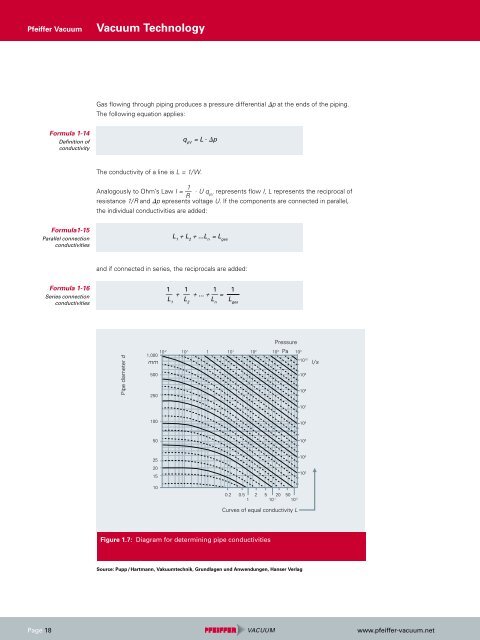You also want an ePaper? Increase the reach of your titles
YUMPU automatically turns print PDFs into web optimized ePapers that Google loves.
Pfeiffer <strong>Vacuum</strong><br />
Page 18<br />
Formula 1-14<br />
Definition of<br />
conductivity<br />
Formula1-15<br />
Parallel connection<br />
conductivities<br />
Formula 1-16<br />
Series connection<br />
conductivities<br />
<strong>Vacuum</strong> <strong>Technology</strong><br />
Gas flowing through piping produces a pressure differential �p at the ends of the piping.<br />
The following equation applies:<br />
qpV = L . �p<br />
The conductivity of a line is L = 1/ W.<br />
Analogously to Ohm’s Law I = — 1<br />
R . U q pV represents flow I, L represents the reciprocal of<br />
resistance 1/ R and �p epresents voltage U. If the components are connected in parallel,<br />
the individual conductivities are added:<br />
L 1 + L 2 + ...L n = L ges<br />
and if connected in series, the reciprocals are added:<br />
Pipe diameter d<br />
1 1 1 1<br />
— + — + ... + — =<br />
L 1 L 2 L n L ges<br />
10<br />
1,000<br />
-2 10-1 1 101 102 103 104 Pa<br />
mm<br />
500<br />
250<br />
100<br />
50<br />
25<br />
20<br />
15<br />
10<br />
0.2 0.5 2 5 20 50<br />
1 10 1 10 2<br />
Figure 1.7: Diagram for determining pipe conductivities<br />
Pressure<br />
Curves of equal conductivity L<br />
Source: Pupp / Hartmann, Vakuumtechnik, Grundlagen und Anwendungen, Hanser Verlag<br />
10 10<br />
10 9<br />
10 8<br />
10 7<br />
10 6<br />
10 5<br />
10 4<br />
10 3<br />
l / s<br />
www.pfeiffer-vacuum.net

















